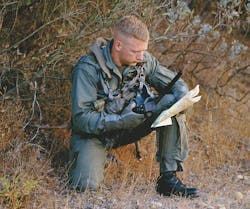Air Force awards $3.2 million contract to Boeing to build 512 CSEL pilot emergency radios
HANSCOM AIR FORCE BASE, Mass., 23 Sept. 2014. U.S. Air Force combat survival experts are ordering more than 500 AN/PRQ-7A hand-held emergency radios for downed aircraft pilots from the manufacturer, the Boeing Co. Defense, Space & Security segment in St. Louis.
Officials of the Air Force Life Cycle Management Center at Hanscom Air Force Base, Mass., announced a $3.2 million contract to Boeing last week for 512 AN/PRQ-7A hand-held emergency radios as part of the Combat Survivor Evader Locator Hand-Held Radio (CSEL HHR) full-rate production 6 lot 3 program.
The AN/PRQ-7 RF and microwave equipment is an integral component of the CSEL system, which is the U.S. Department of Defense (DOD) program of record for joint search and rescue. CSEL gives search-and-rescue forces precise geo-positioning information and secure over-the-horizon and line-of-sight two-way data communications.
The AN/PRQ-7 is a multifunction handheld radio that enables the warfighter to communicate position and text messages securely through the CSEL UHF satellite communications (SATCOM) network. This system enables the user to transmit and receive position and text message using a secure UHF SATCOM data link to the CSEL UHF SATCOM base station and national asset system.
Related: Navy sets sights on new combat survivor evader locator survival radio for downed pilots
The AN/PRQ-7 radio is software programmable and upgradable; has a selective-availability anti-spoofing module (SAASM)-based GPS receiver for precise navigation; NSA certified encryption and decryption of over-the-horizon and line-of-sight messages; night-vision-goggle-compatible liquid crystal display; wideband flat-blade antenna; operates in temperatures from -20 to 55 degrees Celsius; and is waterproof to 10 meters of immersion.
The CSEL, of which the AN/PRC-7 radio is a component, provides global coverage for DOD forces worldwide. The system enables joint personnel recovery centers (JPRCs) and recovery forces to locate, authenticate, and communicate with isolated personnel in near real-time anywhere in the world.
The CSEL program is in full-rate production by Boeing. Managing the contract are officials of the Joint Program Office for Personnel Recovery at the Electronic Systems Center, Hanscom Air Force Base.
Related: Boeing receives second production order for Combat Survivor Evader Locator program
The CSEL and its AN/PRC-7 radio are replacing equipment that was effective only if friendly forces were within line-of-sight. This older equipment offered very little to counter the possibility of enemy intercept or jamming.
The Boeing CSEL system is based on a flexible, modular communication architecture over several satellite links for dependable and secure satellite communications, line-of-sight voice communications, global position, navigation and beacon functions.
When activated by downed pilots or other isolated warfighters, the AN/PRC-7 CSEL handheld radio automatically and securely transmits its GPS location and identification information, and helps the stricken pilot and rescuers share messages on the pilot's physical condition, enemy location, rescue plans, and other important information.
For more information contact Boeing Defense, Space & Security online at www.boeing.com/boeing/bds, or the Air Force Life Cycle Management Center at Hanscom Air Force Base at www.hanscom.af.mil/units.

John Keller | Editor
John Keller is editor-in-chief of Military & Aerospace Electronics magazine, which provides extensive coverage and analysis of enabling electronic and optoelectronic technologies in military, space, and commercial aviation applications. A member of the Military & Aerospace Electronics staff since the magazine's founding in 1989, Mr. Keller took over as chief editor in 1995.

